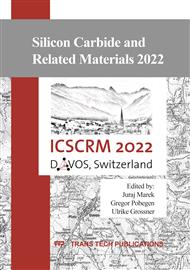[1]
J. R. Weber, et al., PNAS 107, 8513 (2010).
Google Scholar
[2]
M. W. Doherty, et al., Phys. Rep. 528, 1 (2013).
Google Scholar
[3]
N. T. Son, et al., Appl. Phys. Lett. 116, 190501 (2020).
Google Scholar
[4]
M. Widmann, et al., Nat. Mater. 14, 164 (2015).
Google Scholar
[5]
D. Simin, et al., Phys. Rev. B 95, 161201(R) (2017).
Google Scholar
[6]
E. Janzén, et al., Physica B 404, 4354 (2009).
Google Scholar
[7]
V. Ivády, et al., Phys. Rev. B 96, 161114(R) (2017).
Google Scholar
[8]
S. Castelletto, et al., Nat. Mater. 13, 151 (2014).
Google Scholar
[9]
D. J. Christle, et al., Nat. Mater. 14, 160 (2015).
Google Scholar
[10]
H. J. von Bardeleben, et al., Phys. Rev. B 94, 121202(R) (2016).
Google Scholar
[11]
N. T. Son and I. G. Ivanov, Journ. Appl. Phys. 129, 215702 (2021).
Google Scholar
[12]
G. Wolfowicz, et al., Nat. Comm. 8, 1876 (2017).
Google Scholar
[13]
M. E. Bathen, et al., npj Quantum Information 5, 111 (2019).
Google Scholar
[14]
M. Widmann, et al., Nano Lett. 19, 7173 (2019).
Google Scholar
[15]
C. P. Anderson, et al., Science 366, 1225 (2019).
Google Scholar
[16]
G. Kresse and J. Furthmüller, Phys. Rev. B 50, 17953 (1996).
Google Scholar
[17]
J. Heyd, G. E. Scuseria and M. Ernzerhof, Journ. Chem. Phys. 118, 8207-8215 (2003).
Google Scholar
[18]
C. Freysoldt, et al., Rev. Mod. Phys. 86, 253 (2014).
Google Scholar
[19]
C. Freysoldt, J. Neugebauer and C. G. van de Walle, Phys. Rev. Lett. 102, 253 016402 (2009).
Google Scholar
[20]
J. F. Ziegler, M. D. Ziegler and J. P. Biersack, Nuclear Inst. and Methods in Physics Research B 268, 1818-1823 (2010).
Google Scholar
[21]
D. Drouin, et al., Scanning 29, 92-101 (2007).
Google Scholar
[22]
T. Hornos, A. Gali and B. G. Svensson, Mater. Sci. Forum 679-680, 261-264 (2011).
Google Scholar
[23]
K. Szasz, et al., Phys. Rev. B 91, 121201(R) (2015).
Google Scholar
[24]
A. Beste et al., Phys. Rev. B 98, 214107 (2018).
Google Scholar
[25]
R. Karsthof, M. E. Bathen, et al., Phys. Rev. B 102, 184111 (2020).
Google Scholar
[26]
N. T. Son, et al., Appl. Phys. Lett. 11, 212105 (2019).
Google Scholar



